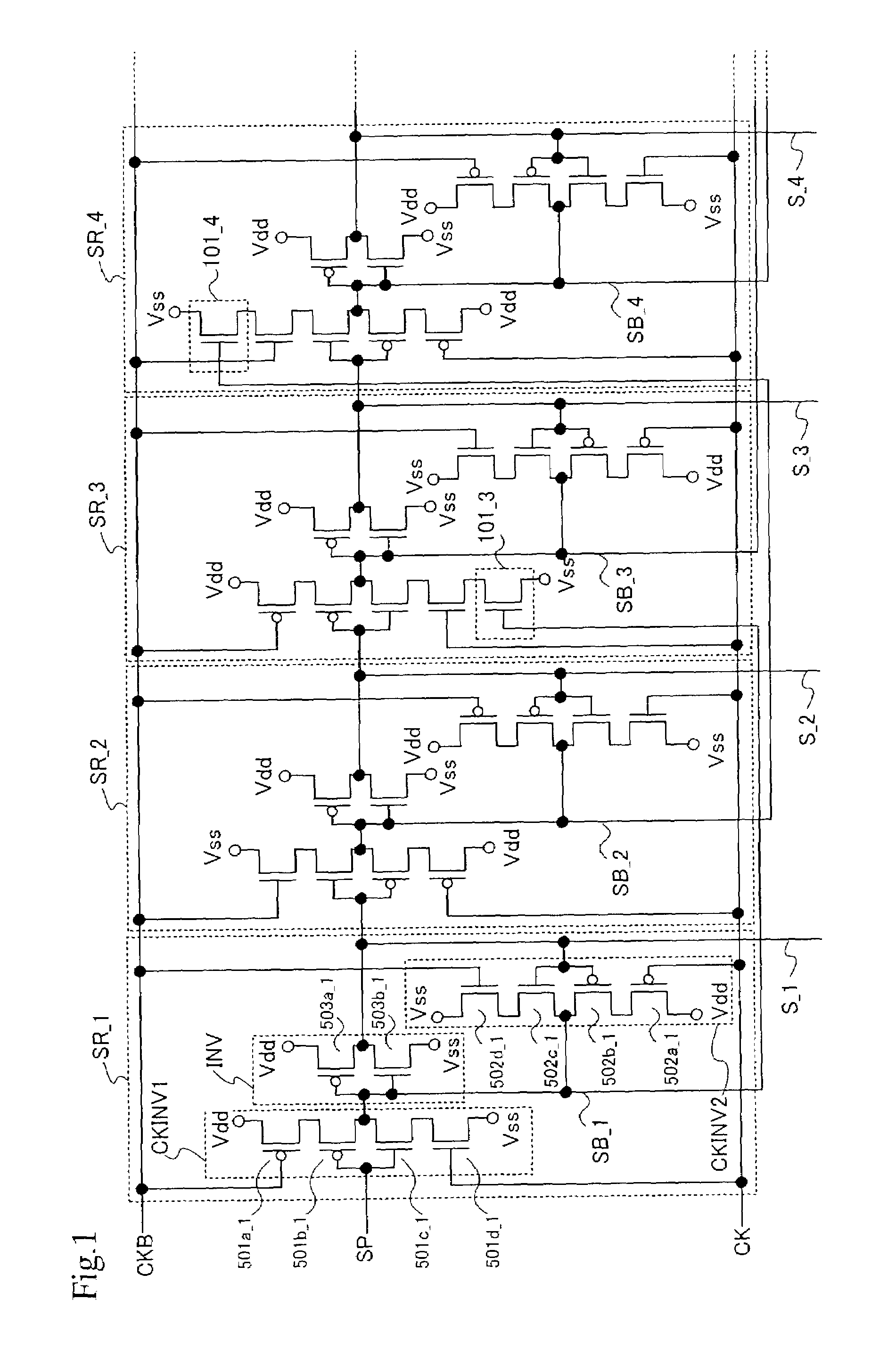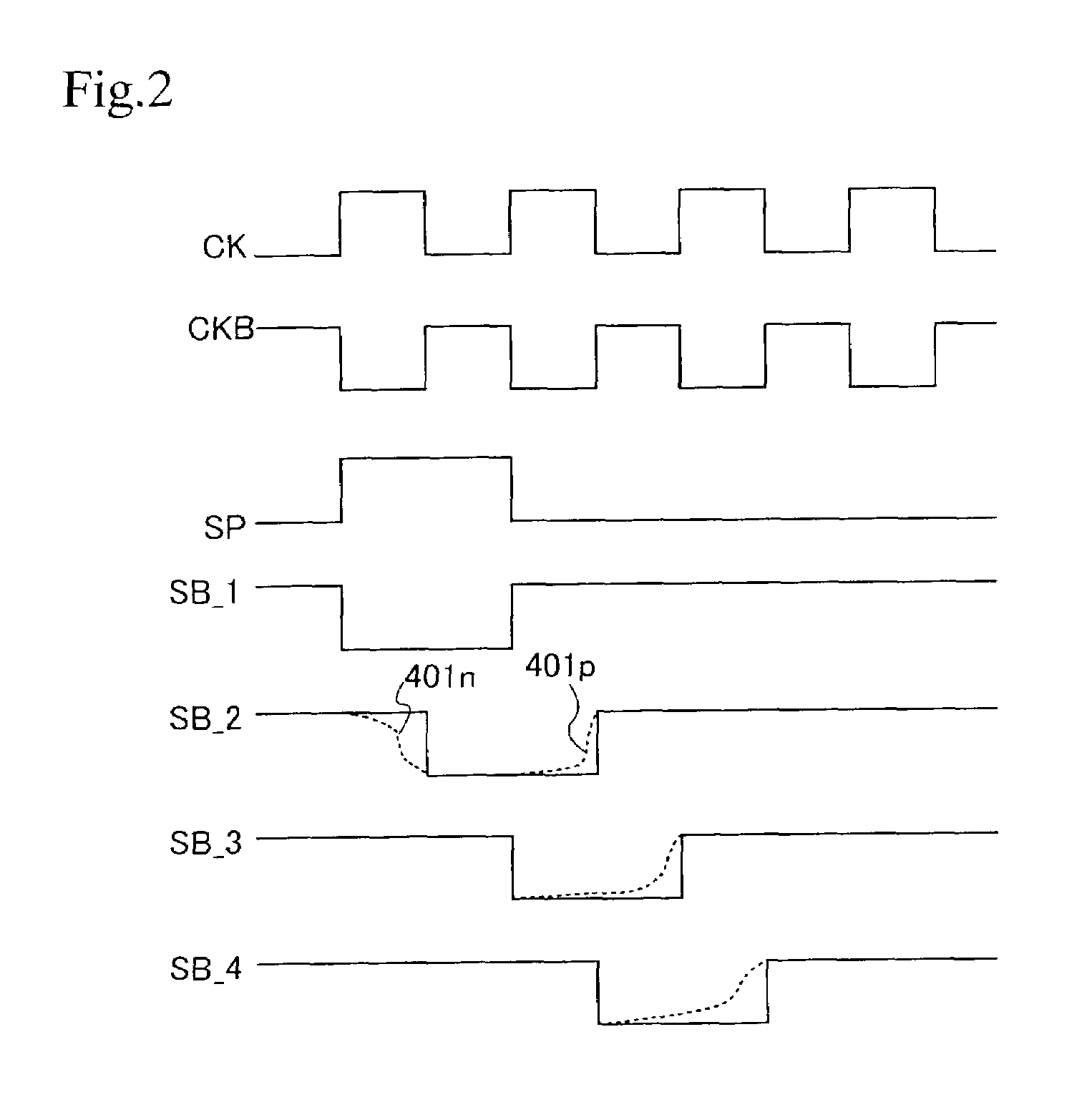Shift register and method of driving the same
- Summary
- Abstract
- Description
- Claims
- Application Information
AI Technical Summary
Benefits of technology
Problems solved by technology
Method used
Image
Examples
embodiment 1
[Embodiment 1]
[0102]A circuit diagram, which is equivalent to the circuit diagram of FIG. 4 as an example of prior art, is used to describe a shift register according to Embodiment 1 of the present invention. Identical components with those in FIG. 4 are denoted by the same reference symbols and explanations thereof are omitted.
[0103]The shift register of the present invention receives a start pulse SP and clock pulse CK with a smaller amplitude voltage than power supply voltage (corresponding to a electric potential difference between a high power supply electric potential Vdd and a low power supply electric potential Vss) of the shift register.
[0104]Here, each stage of the shift register has a first clocked inverter and a second clocked inverter. The second clocked inverter CKINV2 has p-channel TFTs 502a and 502b and their gate width is set to ½ or more of the gate width of p-channel TFTs 501a and 501b of the first clocked inverter.
[0105]The gate width of a TFT here refers to a le...
embodiment 2
[Embodiment 2]
[0118]FIG. 1 is a circuit diagram which shows the structure of a shift register in Embodiment 2. Components of this shift register that are identical with those in FIG. 4 are denoted by the same reference symbols and explanations thereof are omitted.
[0119]The shift register of the present invention receives a start pulse SP and clock pulse CK with a smaller amplitude voltage than the power supply voltage (corresponding to the electric potential difference between the high power supply electric potential Vdd and the low power supply electric potential Vss) of the shift register. The above causes leak current of a first clocked inverter. This embodiment reduces the leak current by the following structure.
[0120]In FIG. 1, an n-channel TFT 101 is added to the first clocked inverter CKINV1 in the third stage that constitutes the shift register and in each of the subsequent stages to the third stage. The n-channel TFT 101 in the k-th (k is a natural number equal to or larger...
embodiment 3
[Embodiment 3]
[0138]This embodiment describes a shift register structured differently from Embodiment 2 illustrated in FIG. 1. The description will be given with reference to FIG. 8. In FIG. 8. identical components with those in FIG. 1 are denoted by the same reference symbols and explanations thereof will be omitted.
[0139]The shift register of the present invention receives a start pulse SP and clock pulse CK with a smaller amplitude voltage than the power supply voltage (corresponding to the electric potential difference between the high power supply electric potential Vdd and the low power supply electric potential Vss) of the shift register. The above causes a leak current of a first clocked inverter. This embodiment reduces the leak current by the following structure.
[0140]In FIG. 8, the n-channel TFT 101 is added to the first clocked inverter CKINV1 in the second stage that constitutes the shift register and in each of the subsequent stages to the second stage. The n-channel T...
PUM
 Login to View More
Login to View More Abstract
Description
Claims
Application Information
 Login to View More
Login to View More - R&D
- Intellectual Property
- Life Sciences
- Materials
- Tech Scout
- Unparalleled Data Quality
- Higher Quality Content
- 60% Fewer Hallucinations
Browse by: Latest US Patents, China's latest patents, Technical Efficacy Thesaurus, Application Domain, Technology Topic, Popular Technical Reports.
© 2025 PatSnap. All rights reserved.Legal|Privacy policy|Modern Slavery Act Transparency Statement|Sitemap|About US| Contact US: help@patsnap.com



